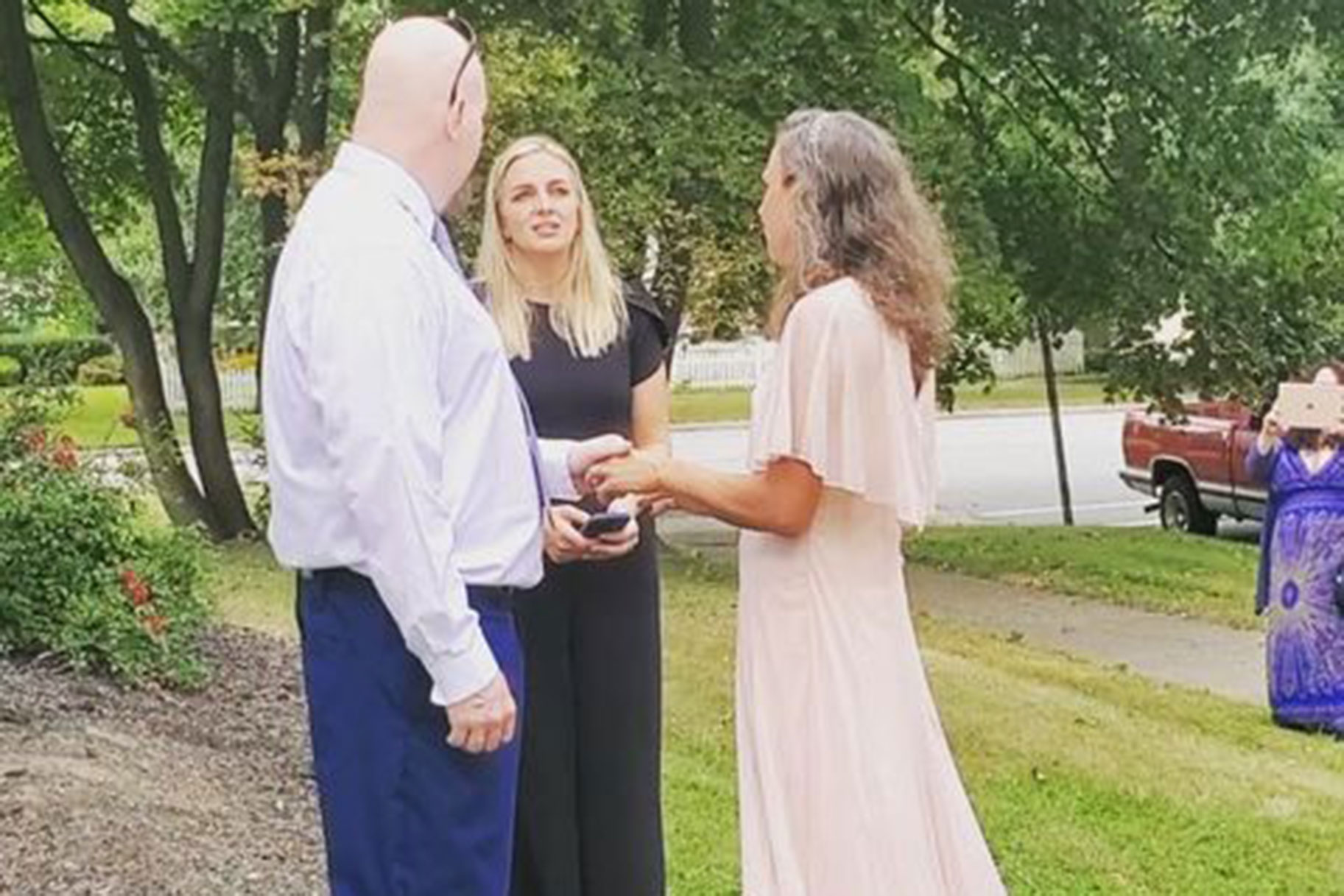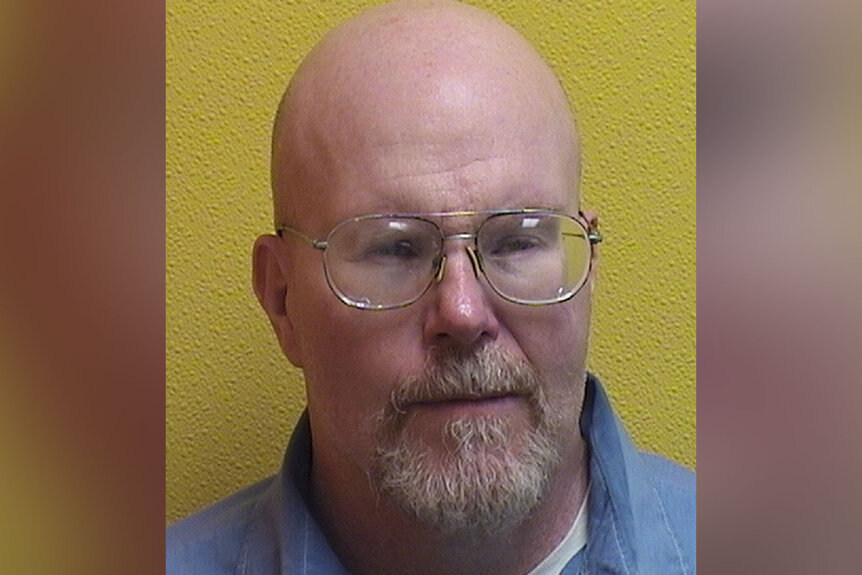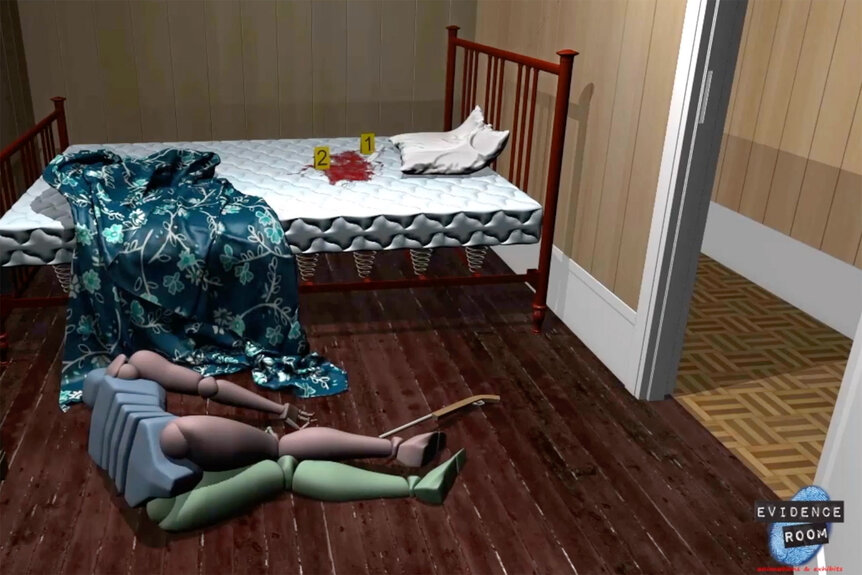Create a free profile to get unlimited access to exclusive videos, breaking news, sweepstakes, and more!
'A Case That Puts The Justice System To The Test': Inmate Convicted Of 1989 Murder Of New Bride's Brother Hopeful About Retrial
John Tiedjen is hoping to be exonerated in the death of roommate Brian McGary after he discovered that evidence, including dozens of crime scene photos that have since been lost, was withheld at his murder trial 32 years ago.

At a joyful Saturday afternoon wedding held earlier this month outside in the yard outside a Cleveland home, friends of the bride and groom joined certain family members and various legal professionals who’d worked with the ankle monitor-clad groom over the years. A brief exchange of vows was followed by pizza, cake, and dancing. Not in attendance at Crystal Straus and John Tiedjen’s nuptials were some members of the bride’s family — legally, the groom was not allowed to be near them, as he’d just been released from prison after more than three decades after being convicted for the murder of his bride's brother, who died in a bedroom in their shared apartment under disputed circumstances 32 years ago.
On July 22, at 57 years old and amid a decades-long battle, Tiedjen was released and is awaiting a second trial for the 1989 shooting death of his friend and roommate, 18-year-old Brian McGary. On April 1, 1989, when he was 25, Tiedjen reported to authorities that he’d found McGary’s body on his bedroom floor. After multiple failed appeals and an application for the reopening of his case, which presented various theories on how McGary died, Tiedjen has learned he has been given a January 31, 2022 trial date, after Cuyahoga County Common Pleas Court Judge Dick Ambrose overturned his decades-old conviction last month and agreed that missing evidence and police reports led to an incomplete picture at the original trial.
After at least nine appearances before a parole board that ended in a denial of his release because he refused to admit guilt, Tiedjen again appealed to the courts in 2017, stating that new evidence — which he pried from the government himself via a Freedom of Information Act request — was withheld at his trial 32 years ago. This, along with advances in forensics and crime scene reenactments, led him to believe that on the night in question, as he was fast asleep in his bed, a heartbroken McGary wrapped his hands in a flannel shirt, drew a target using his own blood on his forehead, then used a long-barreled rifle to shoot himself between the eyes. Ohio prosecutors, however, still maintain that Tiedjen gunned down McGary amid a drunken tussle.
McGary and Tiedjen’s friendship was undeniably tight. According to court documents, the two young men “were as close as natural brothers.” In the years prior to his death, McGary has been taken in by his friend’s family, and just months prior, the two had moved into their own apartment together in Cleveland’s Slavic Village neighborhood; back then, Tiedjen was working at a junkyard pulling grease from motors, he said. The night of McGary’s death, the two housemates had been out at the bars drinking — McGary had been dealing with a break-up from his girlfriend. According to Tiedjen, after the two arrived home drunk, McGary helped him to bed and then likely, as he normally did at night, took a bath. Tiedjen says he found McGary dead in his room the next morning, curled up near the foot of his bed with a one-inch stab wound to the chest and a bullet wound from a .22-caliber rifle directly between the eyes. A circle drawn in blood was on his forehead and a knife in a pool of blood remained on McGary’s bed, as police later detailed, and the rifle was lying across his feet. He was dead.
Panicked, and with an unpaid phone bill, Tiedjen ran from his apartment to the nearest payphone to call his mother, he said, recalling that back then, “Mom was the person that I called because mom always had all the answers.”
Tiedjen was 13 years old when his mother pulled him from school to work alongside his father and help make ends meet for the family. In 1989, Tiedjen said, he had about a 3rd-grade education level. That day, he said, he was deeply confused about how to handle the discovery of his best friend’s dead body. And when he was unable to reach his mom by payphone and now out of quarters, he decided to walk to the home of a girl he knew whose father was a sheriff’s deputy. They were soon able to get ahold of his mother, who helped him notify the authorities about McGary's death. After police looked at the crime scene that afternoon, Tiedjen — who in 1989 was on probation for a disputed rape in 1985 — received a call back for questioning and turned up at the local Justice Center.
“They told me they were keeping me,” he recalled. ”They went ahead and took me into another room. They stripped all my clothes and put me in a blue jumpsuit. Then they started taking me out and interrogating me.”
From here, the justice system moved swiftly. Five weeks later, he was convicted in a jury trial. Jurors were shown a confession signed by Tiedjen saying that in an act of self-defense that night, amid an escalating argument, he’d stabbed McGary then shot him dead after the teenager had retreated to his bedroom.
“By all accounts, [John’s] first several statements are that he had no idea what happened,” Tiedjen's attorney Kimberly Corral told Oxygen.com. “After five or six days in custody, he signed a statement written by the police. He agreed and signed the statement — which is how false confessions happen. None of the physical, forensic, or scientific evidence at all implicates John.”
Tiedjen was handed a prison sentence and has been denied parole every time he’s appeared before the board — flopped, as prisoners and the legal community refer to such a decision — as he has never admitted his guilt in the murder.
Four years ago, as his legal and parole attempts continued to fail, Tiedjen received a letter from his best friend’s sister. Straus said she’d written it when he crossed her mind on a trip to Lake Erie. They’d grown up together, and after looking him up online, she wanted him to know that nearly three decades later, she forgave him for the killing of his brother; the letter let him know that she's “very open-minded, very independent, and very strong ... and she speaks her mind — no matter what,” Tiedjen recalled. So he responded that he shares these same character qualities — but that it’s important to him that she knows he is innocent. Soon, they began to discuss his case over visits and calls, and quickly she began to believe it to be true: Brian McGary had not been murdered and, like his father and some other of his family members, she would later testify, had died by suicide that night. Since she changed her thinking about his death, Straus has stood up for Tiedjen, within her family and publicly, and helped him with his case. This led to an unlikely coupling and what Corral called a “fairytale courtship romance that’s so profoundly beautiful because it's so genuine.”
In multiple interviews with Oxygen.com over the past month, Corral has reiterated her belief that Tiedjen was wrongfully convicted of McGary’s murder and that it was, in fact, a suicide. Furthermore, she says, key evidence that could have swayed the jury’s verdict in 1989, including dozens of photos from the crime scene and a piece of paper from McGary’s pocket, went missing and were never introduced in court. Somehow, after a 2017 hearing, 76 of the photos were lost, according to the court records. Tiedjen’s defense team now must rely on black and white copies of the originals. At that hearing four years ago, Common Pleas Court Judge Nancy Russo denied Tiedjen a new trial and said that the photographs were not exculpatory and would not have altered the evidence that did lead to the original conviction.
The initial case against Tiedjen hinged on the fact that his fingerprints were found on the gun that was used in McGary’s death. However, that gun was owned by Tiedjen, so it follows that his prints would probably be somewhere on it, his attorney says. Meanwhile, the details of what the defense says witnesses have said unfolded that night — including that McGary’s ex-girlfriend was seen leaving the home with another man — were not presented at Tiedjen’s trial. In court, six of 10 photos from the scene of his death were presented; after that 2017 Freedom of Information Act filing by Tiedjen, a total of 87 crime scene photos — which in the 1980s were not subjected to open discovery by his original defense team or seen by the jury that convicted him — were unsealed.
Those images paint a different picture than the Cleveland authorities' theory of a fight and struggle between friends that ended in one’s slaying, Tiedjen and his defense team argue. They say the cache of images, from April 1 and April 6, 1989, show discrepancies, including that Tiedjen’s glasses were placed on a table in some images, then had been twisted and thrown on the floor in others — the latter supporting investigators' theory that there was a struggle. The defense argues that the photos also suggest that McGary’s ex-girlfriend had been at the home with another man, as two leather jackets and a purse can be seen in the evidentiary images. But perhaps the most important piece of evidence revealed via the newly released documents was the piece of paper in McGary’s back pocket at the time of his death, which very well could have been his suicide note, Corral and Tiedjen said.
“The photographs show that [McGary] had a note on lined paper in his pocket. It was removed from his pocket and placed on the coffee table and photographed,” Corral said. “That note was never preserved, documented or logged into evidence. We have no idea what it said.”
When the case went to trial, the existence of these dozens of crime scene photographs was apparently unknown to attorney Daniel Chaplin, who had represented Tiedjen; Chaplin testified to this at the 2017 hearing after the image was unsealed, court documents show.
“The note would have been followed up, and the juxtaposition of the weapon would have been further investigated — but we didn’t do any of that because we didn’t know about it,” he told the court.
At the time of McGary's death — which Corral noted was on the 10-year anniversary of his own father’s death by suicide — he was on mental health medication that is now known to have the potential side effect of suicidal ideation, she said. Tiedjen told Oxygen.com that it was a name-brand version of carbamazepine, which has been shown to increase the risk of suicide.
On Friday, a spokesman for the Cuyahoga County prosecutors told Oxygen.com that the office has some “strong opinions” on this theory that McGary died by suicide, which are laid out in a lengthy motion for dismissal of appeal filed on behalf of the state of Ohio. Cuyahoga County Assistant District Attorney Frank Leznikar wrote that the defense’s case amounts to a “far-fetched theory.”
The DA’s motion cites multiple points of evidence that they believe are damning enough to deny a new trial: Tiedjen's 1989 statements to police that he shot McGary; his alleged admission of guilt to his brother and the fact that the day after the murder he’d asked his pal, Bob Pack, to dispose of a .32 caliber revolver; Tiedjen's fingerprint was found on the .22 caliber rifle that killed McGary; that McGary's own fingerprints were not on the murder weapon; testimony from neighbors; and forensic evidence the county says shows that the gunshot that killed McGary occurred from a distance and that no gunshot residue was found on his hands.
Corral points out that her client’s prints would certainly be on that rifle, as it was his property, not McGary’s. On the point about the revolver, she told Oxygen.com that Tiedjen had indeed asked a friend to dispose of a weapon after the crime — but that revolver was not the same weapon that killed McGary — his .22 caliber rifle was used.
“I think the notion that he got rid of another weapon when he wakes up to a body in his house is not indicative of guilt of murder. It's indicative of not trusting the police, or prosecution for that weapon or a number of things,” she said.
The distance from that .22 rifle and McGary’s forehead at the time of his death has also become a contentious matter, as is outlined in the DA’s motion. Testimony from Scott Roder, an evidence specialist and the head of forensic crime scene reconstruction organization Evidence Room, which created a 3D imaging recreation of McGary’s death, was heard at Tiedjen’s July hearing. Roder, who was contacted by Tiedjen from prison and given the unsealed crime scene photos and case files, testified that according to the records he'd reviewed, police had wrapped McGary’s hands in clear plastic wrap at the apartment, which was not typical protocol. He outlined the oddness of this decision and the mystery surrounding a flannel shirt that went missing from the crime scene in an interview with Oxygen.com.
“[Detectives] took Brian's bloody hands and wrapped them in saran wrap. Gunshot residue will not survive being packaged in saran wrap. You’re supposed to bag them in paper because paper doesn’t have static cling,” Roder argued. “He had used a red flannel shirt to wrap around his bloody hands to hold on to the gun properly when he pulled the trigger. They would have found gunshot residue on that red flannel shirt — but they never checked it — they never bagged it, they never marked it.”
Roder indicated that he is ready to testify before the court to explain why he also believes that McGary certainly died by suicide.
"This is a case that puts the justice system to test,” he added.
Ahead of the pre-trial hearing, the Cuyahoga County District Attorney’s office did not appear to have specifically addressed the matter of the bagging of McGary’s hands or that missing, blood-soaked shirt. The office’s motion does dismiss Roder’s testimony and 3D reconstruction, though, stating both were “replete with numerous falsehoods, inaccuracies, and demonstrated a severe lack of familiarity with the testimony and evidence produced in this case.” It also asserts that the victim's fingerprints were not found on the murder weapon and ultimately dismisses the suicide theory, deriding the notion that police who arrived at the home on April 1, 1989, knew that a suicide occurred then intentionally manipulated the scene to frame an unknown suspect over the next five days.
In addition to the dozens of photos that have been lost, the police reports and other evidence that was never entered as evidence or shown to Tiedjen’s original defense team, even more discrepancies and questions plague the case.
Amid the 2017 hearings, the lead detective in the 1989 investigation was approached to appear in court about the case, which he said he couldn’t recall with any specificity, court documents show; unable to testify because he was bedridden, he’d still recently signed an affidavit, written by the state, detailing the then-28-year-old investigation. Questions also remain as to whether or not McGary’s ex-girlfriend was in the apartment that night with her new beau, or if she’d last been at the apartment three days prior, as prosecutors say she told authorities. Adding to the mystery, an eyewitness said that the two were seen leaving “with great haste” after gunfire went off. But another neighbor at the time said they saw a man leaving the building in the pre-dawn hours.
Ahead of Tuesday’s hearing, Corral said that her hope for the next step in Tiedjen’s legal battle is to set a date next year for the trial to begin. She also said she is hoping the court will loosen his house arrest restrictions and allow him to earn a living as a now-married man.
“He's unable to secure funds for experts for his defense or for legal representation and obviously in the standard case,” she said. “But we're denying him the ability to act in his own defense. And after 32 years of curtailing his liberty, we continue to do so — even after the court has decided that had the state disposed of evidence the outcome would have been an acquittal.”
The state, as it has conveyed in its 1,152-page motion, remains highly confident he can be reconvicted. But Corral begs to differ, saying Tiedjen’s defense has a fuller picture of what happened in that apartment and the days following McGary’s tragic death.
“Now we have all the exculpatory information which lends to John's innocence," Corral insisted. "So they certainly can't prevail in 2021.”
















